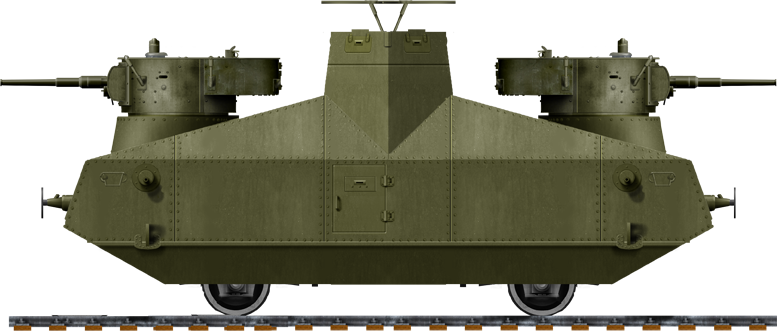
The Armored Trains Encyclopedia
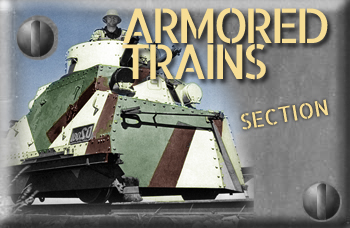 Armored trains are trains that have been equipped with armor plating, weapons, and other defensive and offensive equipment in order to protect them from enemy attacks during times of war or civil unrest. These trains were first used in the mid-19th century during the American Civil War, but they became especially popular during World War I and World War II.
Armored trains are trains that have been equipped with armor plating, weapons, and other defensive and offensive equipment in order to protect them from enemy attacks during times of war or civil unrest. These trains were first used in the mid-19th century during the American Civil War, but they became especially popular during World War I and World War II.
The use of armored trains allowed military forces to quickly transport troops, weapons, and supplies across long distances, while also providing a mobile base for soldiers to launch attacks from. The armor plating on the trains protected them from small arms fire, shrapnel, and other types of weapons, while machine guns, artillery, and other weapons mounted on the trains allowed them to engage enemy forces.
Armored trains also played a role in the Russian Revolution, with both the Bolshevik and anti-Bolshevik forces using them during the conflict. In addition, armored trains were used in the Spanish Civil War, the Chinese Civil War, and other conflicts throughout the 20th century.
While armored trains are not as commonly used in modern warfare due to advances in airpower and more sophisticated ground-based weaponry, they remain an important part of military history and a symbol of the ingenuity and resourcefulness of military planners during times of crisis. However the cold war saw its rapid decrease in popularity, as it was too conspicuous and easy to destroy at a time of air power and increase intel. Still, having a mobile platform of operation hidden in a dedicated tunnel, that can be armed for any defense or offense, armed with ballistic missiles for example, was considered, if not translated into reality. If anything, troops are still transported by train, at least for part of the trip today, but there is not armored train in service anywhere.
Latest Entries

20/10.2025
The D-3 armored draisine was a self-propelled, armored railcar built by for Soviet in the interwar, up to the summer of 1941. The D-3 was developed from 1932 to fill the needs of the Red Army for a mass-produced, heavily armed patrol railcar. To make it affordable, as many of already existing and proven elements were used. The armament consisted in two T-26 tank model 1933 and its engine, coupled with the D-35 gearbox...
16/09/2025  Panzerjäger-Triebwagen (1943)
Panzerjäger-Triebwagen (1943)
The Panzerjäger-Triebwagen (Pz. Jg. Tr. Wg. for short) was a German armored railcar from World War II. Due to the good performance and operational capabilities of the captured Soviet D-2 armored railcars, the Wehrmacht High Command wanted to develop its own vehicles...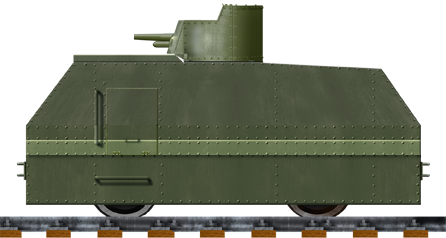
12/08/2025  BD-41 (1942)
BD-41 (1942)
The BD-41 armoured self-propelled railroad car was designed and made between December 1941 and January 1942 in Moskow at Voitovitch plant. The hull was welded from 8-10 mm armoured plates, placed on a chassis of a local auto-section railway car. It was given a standard T-26 model 1931 dual turret, armed with a 37mm and coaxial 7.62 mm, on top of the hull. It was powered by a gasoline front-mounted engine which exhausted both forward of the turret and on the left side, while the crew entered by the side right door. There were seats and ammunition storage for 4-6 men, including two to man the turret, and assistant and a railcar officer. A few DB-41 were manufactured for testing, siverging in some points, at the plant, before swapping to a more advanced model. These were transferred to the 7th separate batallion of armoured trains for trials but not adopted for mass production. Instead, the few prototypes went on to serve in 1942-44 operations until their loss. Note: Future dedicated article on all these different soviet railroad cars planned.

23/07/2025  Panzerlok BP.57 (1943)
Panzerlok BP.57 (1943)
BP.42 last entry: The Panzerlok BP.57, standard armoured locomotive for the whole BP.42 (also used for the BP.44) located at the center of the train, with a symmetrical composition forward and aft. It was based on the civilian very common Prussian G10, with two 3 tonnes 16.5 tenders used exclusively for the BP 42...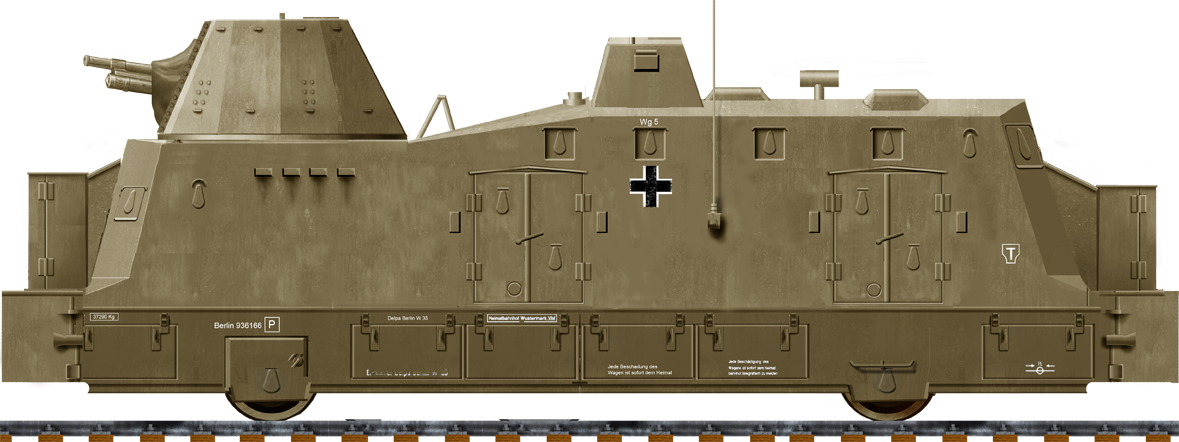
01/07/2025  Haubitzwagen des BP.42 (1943)
Haubitzwagen des BP.42 (1943)
BP.42 third entry: The Haubitzwagen, same turret and ex-Russian 76.2 mm field howitzer, but dedicated fire control, more ammunition. For the BP.44 they were upgraded with a 105 mm howitzer.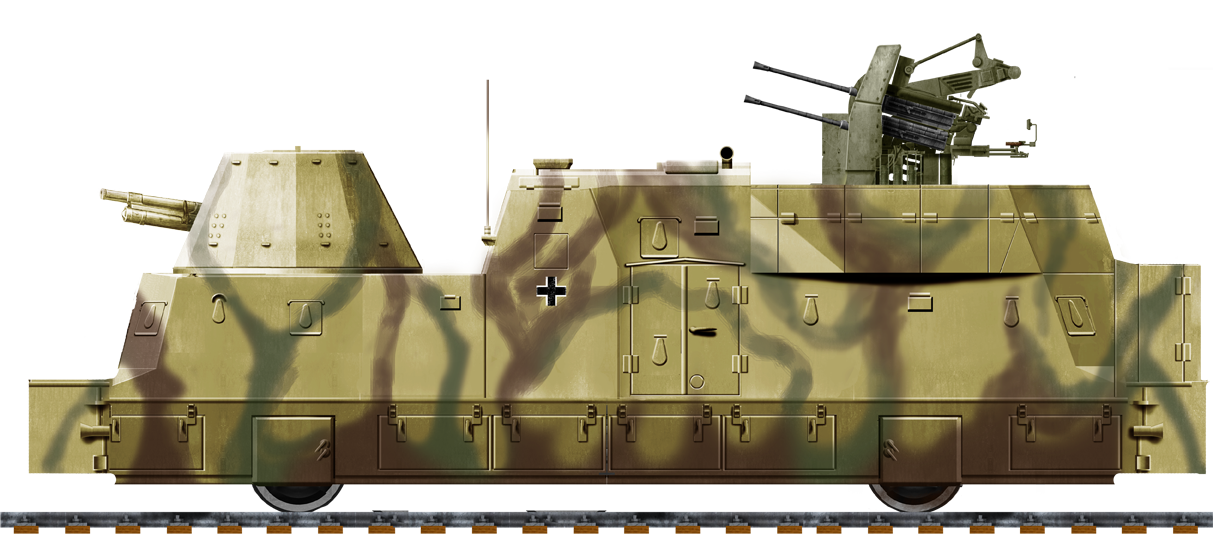
23/06/2025  Flakwagen des BP.42 (1943)
Flakwagen des BP.42 (1943)
BP.42 Second entry: The Flakwagen, mixing a Russian 76.2 mm howitzer with the Flakvierling quad 20 mm AA battery.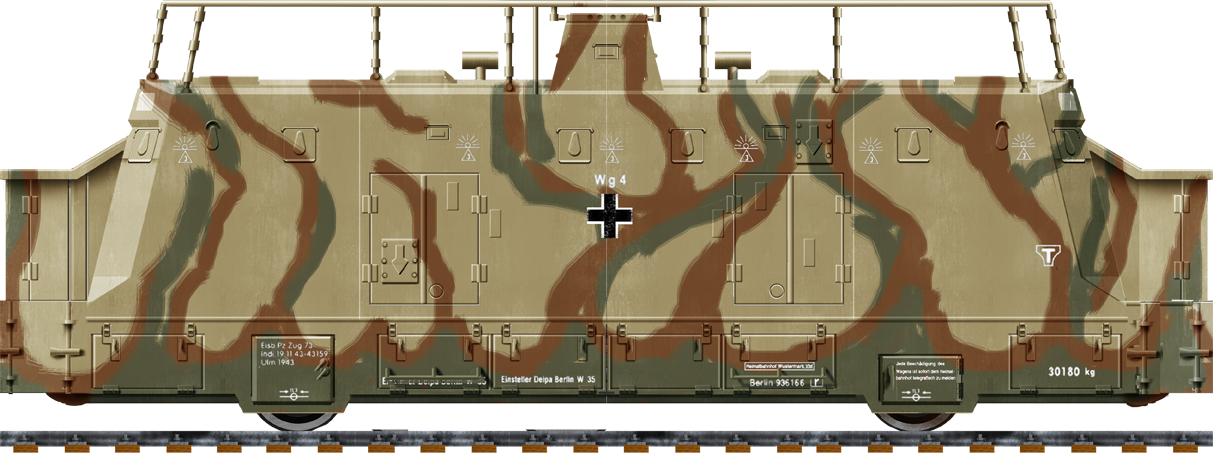
17/05/2025  Kommandowagen des BP.42 (1942)
Kommandowagen des BP.42 (1942)
The The BP 42 (long form: "Behelfsmäßiger Panzerzug 1942" where Behelfsmäßiger means "makeshift") was a German armored train class in the Second World War, used by the Wehrmacht. It represented several armored trains produced to be used mosty on the eastern front at the end of December 1942 and replaced by the BP-44. The history, composition, design, organization, tactics, and specific elements of the train will be seen here over the next months with regular updates. First entry: The Kommandowagen.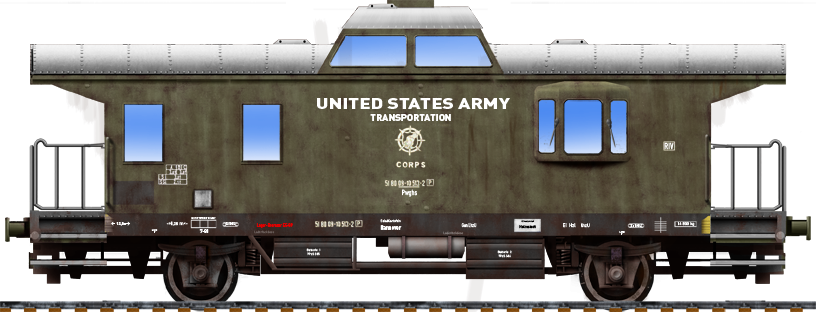
19/04/2025 
For once, not an armoured train, but an interesting wagon nonetheless: The Berlin Duty Train Caboose. A guard escort carriage (known in the US as a ‘caboose’) from the US Army Berlin Duty Train. The Berlin Duty Train was operated by the Transportation Corps and operated from December 1945 to December 1990 between Bremerhaven on the Baltic Coast and Frankfurt am Main to West Berlin. Aside from the train driver/engineer (West German Deutsche Bundesbahn employees within West Germany and East German Deutsche Reichsbahn employees across East Germany), the train crew comprised a Transportation Corps first or second lieutenant as train commander, two MPs, a radio operator, a conductor, and an interpreter, who were based in this caboose. The carriage had observation bubbles on each side and on top, fitted with windscreen wipers, to keep an eye on the progress of the journey.

18/03/2025  Legkaya Broneploshadka PL-37 (1939)
Legkaya Broneploshadka PL-37 (1939)
The PL-37 was the later standard light artillery armoured wagon common to the BP-35 armoured train, replacing the earlier PL-37, and generally with two affected to each composite train (two light PL-35/37, one PT-35 heavy artillery wagon). Only 24 PL-37 were maufactured in 1940-41 until production ceased with Operation Barbarossa. Each 77t wagon had two 76mm field gun turrets, four 7.62 mm Maxim Machine gun ports, and observation turret, a crew of 30 and a lot of ammunition. They were not popular, cramped, dark and hot. The few that survived the first weeks of 1941 were captured or recycled into later BP-43 trains.

14/02/2025  Panzerträgerwagen ATG-7 des BP42/42 (1942)
Panzerträgerwagen ATG-7 des BP42/42 (1942)
The Panzerträgerwagen ATG-7 was an armoured flatcar designed for the tail end of a BP 42 or BP 44 class German broad gauge standard armoured train. It was housing generally a Panzer 38(t) as the only mobile component of the armoured train, outside the schienenpanzer that remained on tracks. The system was also used to carry Somua S35 tanks and a prototype self propelled gun on Lorraine chassis. The BP 44 kept the Panzer 38(t) as standard as it was good enough to combat partisans.
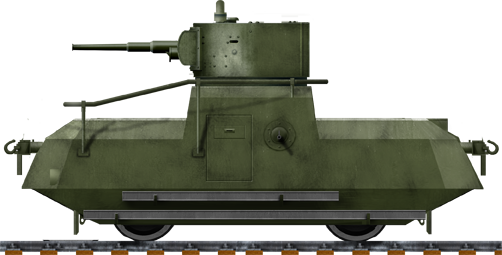
20/01/2025  DT-45 Draisina (1933)
DT-45 Draisina (1933)
The DT-45 was a development of the D-37 in 1933, modernized for railroad track protection as well as a scout car for armoured trains. The new railroad vehicle shared the same armoured hull and powerplant as the D-37 (40 hp Ford initially, later probably 50 hp) in the hull's ball mounts, close to the small entry doors. The turret was a midified version of the BT-26 light tank, with a 45 mm 20-K main gun and coaxial 7.62mm DT machine gun. It was also given a horseshoe bedframe antenna attached around the hull, connected to a 71KT radio and permanent operator for a crew of 7: 2 drivers (fore and aft), one commander and gunner in the turret and two MG gunners. Like the D-37 it did not entered mass production, and the few built to improve over the 1932 D-37 Draisine were used for training draisine crews in 1940.
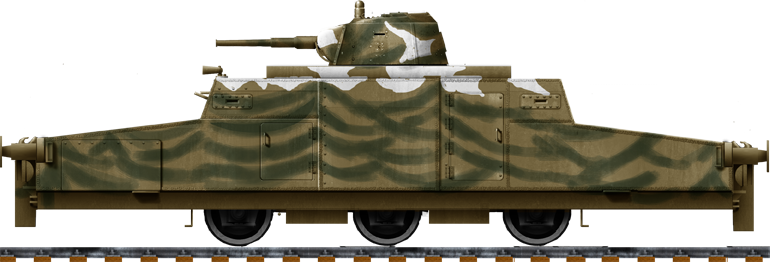
21/12/2024  Zeppelin (1942)
Zeppelin (1942)
"Zeppelin" is a unique Finnish WW2 armored railcar. It was manufactured between 1940 and 1941 with sources conflicting if there was one or more of these draisines, possibly in 1941. It was created from various armored vehicles captured by the Finns in the Winter War, ntably a BA-10 turret housing a 45mm cannon and single 7.62mm DT machine-gun. The engine is unknown, possibly a pair of engines from Komsomolets artillery tractors and two gearbox and a twin driver compartment for quick reverse, with a crew of 4-6. It took part in the continuation war until 1943, and lost likely during the siege of Leningrad. "Zeppelin" was also camouflaged and had armoured shutters, two main side access door and a triple bogie. see also: Finnish WW2 armoured Trains

23/11/2024  Littorina Blindata (Libli) M42/43 (1942)
Littorina Blindata (Libli) M42/43 (1942)
The Littorina Blindata or "LiBli" M42 was an armored railcar used in Italy and the Balkans from late 1942. It was based on the diesel-powered ALn.56, completely modified Ansaldo-Fossati workshops in Genoa. Shortened and armoured, the first eight of the M42 sported two M13/40 tank turrets, six MGs, two mortars and two flamethrowers, whereas the M43 (eight built) had two M15/42 turrets, a 20 mm Breda 35 AA, and four MGs. Their crew could reach 15 men, and they were deployed in independent units mostly for anti-partisan warfare in Yugoslavia. Two were destroyed in combat before the 1943 armistice, and the rest were used by the Wehrmacht until 1945.
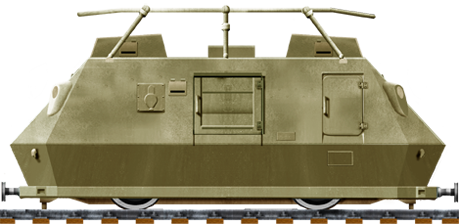
25/10/2024  Leichte Schienenpanzer le.SP 1943
Leichte Schienenpanzer le.SP 1943
Update on the German Panzer Draisines of WW2. This one is for the Panzersicherungswagen Le.Sp light reconnaissance armored railcar. This model was based on a Steyr K2670 draisine covered with light armored plates (resistant to small arms fire and up to 14.5 mm against 20 mm rounds) and weighting 7.5 t, 9.5 tons fully loaded. These were draisines in the sense they were fully motorized and considered like proper "armored cars" on rails. They were produced from 1943, and able to operate independently or in series 300 armored trains, they were crewed by 4 to 8 men, with four MG.34 machine guns... Around 40 were made, they soldiered mostly between the Balkans and East Europe, mostly in anti-partisan missions and later eastern front evacuations.

14/08/2024  Kozma Minin, PL-42 Tank Railcar (1942)
Kozma Minin, PL-42 Tank Railcar (1942)
Kozma Minin was a World War II armored train, named for a Russian merchant who helped Prince Dmitri Pozharsky to defend Russia against a Polish invasion in the early 17th century. The armoured train was completed in February 1942 featuring an armoured locomotive, trailer, two AA/Rocket armoured railcars and two twin T-34/76 tank turrets/four light machine guns railcars. Kozma Minin's sister BP-660 was almost identical and also famous, soldiering in 1942-45 from Ukraine to the outskirts of Berlin.

24/07/2024  Draisine K (1933)
Draisine K (1933)
With the poor performances of the Tatra T-18, Polish Colonel and engineer T. Kossakowski suggested to put FT tanks into tank-propelled draisines, prototypes being made in 1931-33, production was approved in 1936, 23 "drezyna pancerna Typu R" bing made. Alongside, the same idea was applied to more recent TK tankettes. The Draisine TK was born. Circa 50 were manufactured to 1936 to 1939 and they often operated in TK-R-TK units, with the Renault FT tank in between, one on eaither side of the armoured train for reconnaissance on both direction of the tracks, some having radios. They were quick to detach while being cheaper, simpler to manufacture.

13/06/2024  D-37 Draisina (1932)
D-37 Draisina (1932)
The D-37 type Draisine appeared as one of the first dedicated interwar Red army railway car. Designed in 1932 it sported the D-38 turret equipped with up to two DT machine guns (coax and turret back), and a 76 mm short barrel model 1927 gun, for railroad protection and scout for armoured trains. It was made with an uni-body with well sloped angular plates, welded together, and 12 mm (0.5 in) fore and aft and on the sides, 6mm (0.28 in) elsewhere.
It was powered by a 40hp licence-made Ford engine located in the lower part of the hull, with the fighting station above. In addition to the turret there were two more DT MGs in ball mounts close to the only access doors. It seems an AA station with twin Maxim machine guns was also located in the rear hull, covered by a two piece hatch. It was open when needed and the mount manually raised. The D-37 in the end never entered production, remaining a test bed for for the DT-45 Draisine, notably found underpowered.
They had still special devices fore and aft that were kept for future models. This helped to rapidly swap tracks when parallel if available, or going on damaged tracks, or just free the tracks for passage of another train. This consisted in a leaf spring blocking system, two jacks, two pair of beams to be joined together making a full rail section. The leaf springs allowed wheels to lift together with the vehicle, the railcar was hoisted using the two jacks up to a level where the wheel flanges were clear of the rails, and pivoted on the transfer beams when assembled, placed on rails, fixed to them with special brackets and joined with spacers.
Two small casters each end prevented the wheels to roll over. When done, the railcar was simply pushed onto the nearby track or aside with the 4 men of the crew and/or a winch of at least 500kgs pulling capacity, tied to a nearby telegraph pole or equivalent. The beam pairs wa spresent on the car sides with its brackets and remaining equipment carried inside the hull.
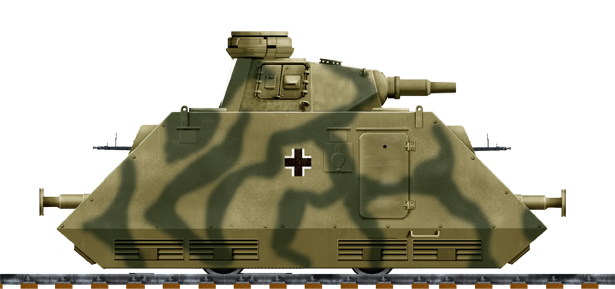
15/05/2024  Panzerdraisine (1942)
Panzerdraisine (1942)
As the frontine started to be more static by late 1942, it became vital for the Wehrmacht to protect its communication lines, notably railways, especially when the Russian dirt tracks became quagmires or were clogged by knee-deep winter snow. When trucks failed, trains always went through, but they were often targeted by partisans. By late 1942 it was specified the construction of a family of draisines variants that can be independently used or joined together to create makeshift armoured trains. Here is the first post on a serie dedicated to those.

20/03/2024  Krasnaja Zvezda (1942)
Krasnaja Zvezda (1942)
Work on creating armored trains or draisines using tank elements (mostly turrets) started in USSR in the early 1930s. So, over the course of several years, the D-37, DT-45, BD-39 railcars appeared on the basis of a standard M 3/2 motor vehicles mass-produced by the Kaluga plant and with T-26 tank turrets. However between their low engine power (40 hp) and weak armor (9-15 mm) they failed to effectively solve their assigned combat missions. Therefore, they were not widely used and not mass-produced. Indeed by June 22, 1941 during Operation Barbarossa, only nine were available with the Red Army.
In December 1941, Kolomna Locomotive Plant (V. Kuibyshev plant) or rather, what remained after its evacuation by October 1941 was repairing KV tanks and V-2K diesel engines coming from the frontline. This became the basis for starting a new design of “diesel locomotive with a powerful armor protection and armament”. Work was carried out under the guidance of engineer Lebedyansky, famous steam locomotive designer. Even before the war, on instructions of the Automotive Tank Directorate of the Red Army, he worked on a project for an armored diesel locomotive. Work proceeded very quickly and by February 1942 the final vehicle "Soviet Red Star track motor car" was ready.
The body of of this armoured draisine "Krasnaja Zvezda" consisted of two longitudinal I-beams and a frame made of a L-section beams riveted together, to which armor plates were attached, welded together after being bolted on the frame. The undercarriage comprised two biaxial bogies of same design. Each was equipped with a V-2K engine, one to move forward, and the other backward. So technically it had a total output of c1400 hp (unitary 340–520 kW (460–700 bhp)) could run at the same speed in either direction. Each bogie had the V-2K engine using transmission via a cardan chain, a large fan extracting air from below to cool the engine, and a chassis developed by M. Svirin according to archives.
Thus despite the large armoured structure, estimated to be 13 to 50 mm (face and rear) in thickness, the "Krasnaja Zvezda" was much faster than a KV-1 model 1940 (angular, all welded) only keeping its turret and 76 mm main gun, coxial 7.62 mm KPT and rear ballmount of the same. Crew was three for the turret, two drivers, one commander, two mechanics, two extra MG-gunners located in the two ball mounts on either side. As for its fate, "Krasnaja Zvezda" fought near the plant, on the railroads used to transport tanks in and out, but this section is still in research...


20/03/2024  Draisine R (1933)
Draisine R (1933)
After the disappointment of the Tatra T-18, Polish Colonel Tadeusz Kossakowski from the Army's Engineering Department suggested to "recycle" old Renault FT tanks into draisines. Prototypes were made in 1931-33 and production was approved in 1936. A total of 23 "drezyna pancerna Typu R" were thus made, and assembled in platoon as a ratio of 1/2 Draisine TK, using instead Tankettes. The carriaged were self-propelled via the tank engine and they can dismount as well, allowing up to 57 kph on rail in best conditions. They saw heavy action during the grim campaign of September 1939.
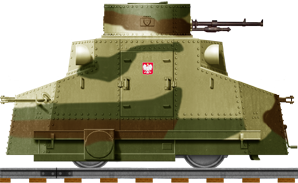
13/02/2024 
The Tatra T18 draisines (self propelled armoured railcars) were designed by Tatra on a private venture for a need of the Polish Army, tested and six ordered in 1925. A single one was retained by the Czechoslovak army. They were criticized for their small speed and anemic engine, but saw combat in 1939 in two armoured trains (three destroyed, one captured) while the sole Czech T18 was used for exercises until captured in 1938.

12/01/2024 
Zaamurets is certainly one of the most famous armoured train that was ever built, perhaps less because of its strenght or composition, but more due to its very long career and properly amazing story, crossing an immense continent. Zaamurets indeed went under several names, changing hands many times, being damaged, repaired, refitted, grew from various additions and other trains to become a truly fascinating monster armoured train seeding terror from eastern Europe and into China.

12/12/2023 
Called the Panzerjägerwagen (Panzerzug BP42/44) or Panzerturm IV auf Panzerzugwagen, or simply zugpanzer IV, this armoured railway carriage was a created for the standardized BP 44 German armoured trains intended for the eastern front. About 20-30 were created, since two could be used symetrically in panzerzug composition. They used Panzer IV Ausf H and often carried additional Schürzen armour. Created for the BP 44 Panzerzug, they were retrofitted to the BP 42s still in service when possible. Unlike ro-ro carriages for the Panzer 38(t) or Panzer 35-S 739(f), the Panzer IV ausf H was fixed, and the name denoted a purely antitank use.

17/11/2023  Danuta class
Danuta class
Danuta and Poznańczyk (N°11 and 12 in 1939) were probably the most famous Polish Armoured Trains. Veterans of three wars (WWI, Polish-Soviet war, WW2) they had been modernized in the interwar by Cegielski Works and KBPP in Poznań, notably with new armoured artillery wagons, T3i armoured locomotives and assault wagons. They took part in the harsh combats on September 1939, illustrating themselves in fierce defence.

15/10/2023  MBV-2
MBV-2
The MBV-2 was the heaviest WW2 self-propelled armoured carriage. Two were made by the Kirov Factory in 1938, armed each with six machine guns and three T-28 tank turrets. They were rearmed during the war with L-11 for one, and F-34 for the other, from the T-34/76 of the 1940 and 1942 types. They served with the Leningrad Front, 14th Independent Armored Train Battalion. On is now preserved at Kubinka.
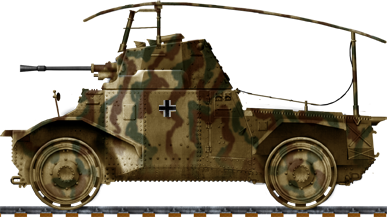
09/09/2023  Schienenpanzer 204(f)
Schienenpanzer 204(f)
The Panzerspähwagen 178 P 204(f) Schienenpanzer was based on the French Panhard AMD-35 reconnaissance armored car. c190 were captured b the Wechmacht after the capitulation, and c40-43 of these were later recycled in 1941 as reconnaissance draisines, screening in front of supply trains and looking for partisans and saboteurs in Russia. They all served on the Russian Front used until the end of the war...
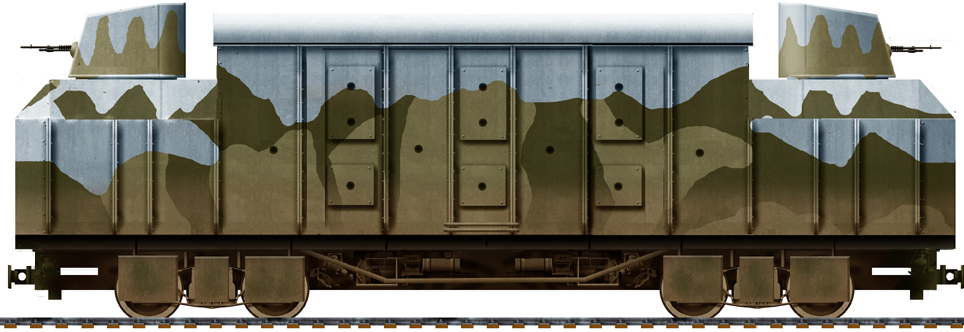
19/05/2023  Paulista War Armored Trains
Paulista War Armored Trains
Better known officially as the "Constitutionalist Revolution", this Brazilian civil war is certainly less well known that the Spanish civil war of 1936-39, bit it was as bitter and hard-fought, with as much modern technology as was the latter, but concentrated on barely five months. Trains were intensively used, and several TB series trains were used by the loyalists, as well as a few by the rebels, including several armoured ones such as the famous "Fantasma da Morte".
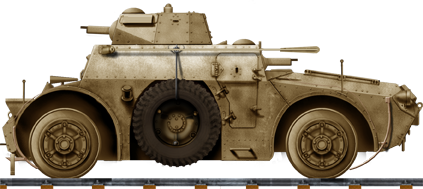
27/01/2021  Autoblinda ‘Ferroviaria’
Autoblinda ‘Ferroviaria’
The AB series armored cars were the main reconnaissance vehicles of the Italian Royal Army during the Second World War, with over 700 being produced between 1940 and 1945. Used on all the fronts of the war, after 1943, 120 were also used by the Germans and, after the war, by the Italian Army until 1954. A total of 20 AB40 and AB41 armored cars were modified in 1942 to patrol the Yugoslav railways. This special version was called ‘Ferroviaria’ (English: Railway). After the war, another group of AB41 and AB43 vehicles were modified to be used to patrol the Italian railways.
Birth in 1840s
 The idea of carrying troops rapidly using train is not new, but almost went back to the birth of the train itself. The core idea behind the train, which almost precluded the internal combustion engine powered automobile by 80 years, was that the musteting of enough steam power for towing any load, needed the express condition to be based on the smoothest surface possible to minimize friction to the minimum, and thus, made the best of the available output, which was weak at the time. Image; the pioneering Trevithick's 1802 Coalbrookdale locomotive.
The idea of carrying troops rapidly using train is not new, but almost went back to the birth of the train itself. The core idea behind the train, which almost precluded the internal combustion engine powered automobile by 80 years, was that the musteting of enough steam power for towing any load, needed the express condition to be based on the smoothest surface possible to minimize friction to the minimum, and thus, made the best of the available output, which was weak at the time. Image; the pioneering Trevithick's 1802 Coalbrookdale locomotive.
The only way to achieve this perfect surface was to built it, and the railroad concept was born. It practically never changed from the early XIXth in basic concept: The Railway Track is essentially composed of longitudinal iron (and later steel) beams as rails, fasteners, railroad ties and ballast or slab track, plus the underlying subgrade. The task of building one railway track was soon assimilated as building a road, but with even more care and accuracy, by planning far by advance the path through forests and mountained, rivers and such. This went in pair with the birth of civil engineering and the XIXth industrial revolution.

Indeed, tunnels had to be bored, and bridges had to be constructed over any obstacle, sometimes both in succession. The railroad, became soon an unmistakable symbol of human ingenuity on an untamed landscape, crossing the land without obstruction from coast to coast and symbolizing modernity. It was soon an obligatory show for any industrialized nation to criss-cross its own territory for a dense network and efficient timetables.
The first iron rails laid in Britain were at the Darby Ironworks, Coalbrookdale, in 1767. Steam locomotives were introduced in 1804, but the track then in use, adapted for mine work, proved too weak to carry their weight. Richard Trevithick's locomotive for example broke the Pen-y-darren plateway track but progresses were rapidley made in the 1810s and 1820s, with better rigid track formations. The technique adopted was to have iron rails mounted on stone sleepers, plus cast-iron chairs holding them in place. Eventually these were supersded by flexible track structures, which became the norm.

In all capitals, grand buildings shaped and thought as palaces raised off the ground, often under state subsidies: The railway stations became soon a source of awe and wonder. Not only for their appearance and size, but also soon for what they did not show, the promise of a long and safe travel for days on end. It became clear at the end of the XIXth Century that soon any point in Europe would be reachable by train, and nations opened their network to allow this, sometimes with resistance. The Train really eased travel for a century for millions of Europeans and Americans, enabling economical growth in a way that was unimaginable before, notably long travel of goods, sometimes from a country to another. This was the end of a localized economy and the birth of globalized one.
However its use for transporting troops made sense for some countries, like France and Germany, that soon saw a way to rapidly muster troops on their border, a perfect recipe for a rapid mobilization. The train could also carry guns, ammunitions, horses for the supply train or an organic cavalry unit as well. From the "landing point", troops would dismount and advance to take position, rested. This was in stark contrast of Napoleonic style of warfare when troops were limited to their pace, had to rest for the night, and needed a huge baggage train to follow them.
The case of Prussia/Germany
Prussia only really saw an interest in having a train for military operation after the Austro-Prussian War of 1866, when it took, various private, commercially oriented lines under Prussian state control through annexation, purchase or conditioned financial support. Between 1880 and 1889 all the existing lines and assets were nationalised thanks to Prussia's strong financial situation. In 1870 already, they played a role in bringing rapidly troops to the border with France, although this was still a fraction as the rest of "Germany" (a collection of sovereign states) had no uniform railroad policy yet.France also had a comprehensive railroad network but it did not took full advantage of it. Under Napoleon III, if industry and finances were given a boost, new lines and stations being created, French mobilization was halp-hazard and really dragged on, which enabled German troops to muster larger forces from the start (It did not explains fully the French defeat in 1870, but was a part of it). It should be noted that the us of trains for troops deployments and supply was not a European but American invention: It was developed as an art form during the American Civil War seen in detail below.
In WWI, Germany, now united at Versailles as an Empire following Bismarck's victory, made of of its priorities of standardizing and developing its railroad network much more extensively, now thought of as a rapid mobilization tool. It must be said that aside this, the 1870-1890s "colonial race" between Europan nation was also translated by the creation of railways in Africa and Asia or the Middle East. Although dairly paid by local populations (like in Belgian Congo) it nevertheless created new ways of transportation intended to boost economical profitability at first, but which stayed as a benefit for the concerned countries future economies in the cold war.
WWI erupted and when war was declared, troops mobilization largely counted on trains to be effective. In fact the image of freshly recruited troops outfitted from the barracks kissing their loved ones on the quays as their train departed for the front, marked collective imagination, most hoping for a short war. In this exercize, the concerned nations were not all at the same foot (to be continued...).
Armored Trains of the American Civil War
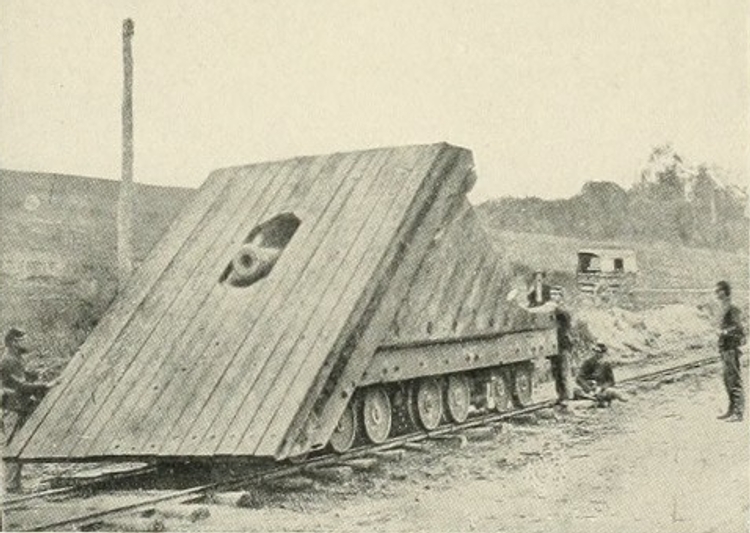 Armored trains were not used during the American Civil War as the technology had not yet been developed. However, there were some armored railroad cars used by both the Union and Confederate armies during the conflict.
The Union army used several armored railroad cars, known as "ironclads," during the war. These cars were essentially flatcars that had been fitted with iron plates on the sides and roof to protect them from enemy fire. The ironclads were used to transport troops and supplies across the front lines, and they were also used to protect troops during battle.
Armored trains were not used during the American Civil War as the technology had not yet been developed. However, there were some armored railroad cars used by both the Union and Confederate armies during the conflict.
The Union army used several armored railroad cars, known as "ironclads," during the war. These cars were essentially flatcars that had been fitted with iron plates on the sides and roof to protect them from enemy fire. The ironclads were used to transport troops and supplies across the front lines, and they were also used to protect troops during battle.
The Confederate army also used armored railroad cars during the war, but they were not as heavily armored as those used by the Union. The Confederate cars were typically fitted with iron plates on the sides and had loopholes for small arms fire, but they did not provide as much protection as the Union ironclads.
Overall, the use of armored railroad cars during the Civil War was limited, and they were not as effective as other means of transportation, such as wagons and steamboats. However, they did provide some protection for troops and supplies during transport, and they helped to pave the way for the development of more advanced armored trains in the years that followed.
Trains nevertheless played a very important role in the American Civil War, serving as a crucial means of transportation for troops, supplies, and equipment. The use of trains allowed armies to move quickly and efficiently across long distances, which was particularly important given the size of the country and the vast distances that had to be covered during the war.
Both the Union and Confederate armies relied heavily on trains during the conflict, with rail lines and stations becoming strategic targets for both sides. The Union had an advantage in terms of railroad infrastructure, as they had more tracks, locomotives, and rolling stock than the Confederacy. However, the Confederacy also made effective use of their railroads, using them to transport troops and supplies throughout the South.
One of the most famous examples of train use in the Civil War was the use of the B&O Railroad during the Battle of Monocacy in 1864. Confederate forces under General Jubal Early attempted to capture the railroad, which was a key supply line for the Union army, but were ultimately unsuccessful.
Trains were also used for medical evacuation, with specially equipped trains used to transport wounded soldiers from the battlefield to hospitals and medical facilities. This was a significant development in military medicine and helped to improve survival rates for injured soldiers.
In addition to their military uses, trains played a role in the war effort on the home front as well. Railroads were used to transport goods and supplies to cities and towns throughout the country, helping to sustain the war effort and keep civilians fed and clothed.
Overall, the use of trains during the American Civil War demonstrated the importance of transportation infrastructure in modern warfare and helped to pave the way for future developments in military logistics and transportation.
Armored Trains of WW1

Hungarian MÁVAG armoured train in 1914
Armored trains were first used on a large scale during World War I. These trains were primarily used to transport troops and supplies across the front lines, but they were also used as mobile fortresses, providing cover and protection for troops in battle. The Germans were the first to use armored trains during the war, and they quickly became an important part of their military strategy. The trains were heavily armed with machine guns and artillery pieces, and they were protected by thick armor plating. The Germans used the trains to transport troops and supplies to the front lines, and they were also used to support infantry units in battle.
The Russians also used armored trains during the war, primarily to transport troops and supplies across their vast empire. The trains were heavily armed and armored, and they were used to protect Russian troops from enemy fire. The British and French also used armored trains during World War I, but they were not as heavily armed or armored as those used by the Germans and Russians. The trains were primarily used to transport troops and supplies, and they were equipped with light machine guns and anti-aircraft guns.
Overall, armored trains played an important role in the military operations of several countries during World War I. They helped to transport troops and supplies across the front lines, and they provided cover and protection for troops in battle. However, advances in technology, such as tanks and airplanes, soon made armored trains less effective, and their use declined in the years following the war.
Austria-Hungary: MAVAG Typ AE panzerzug
Belgium: Light armoured train
Belgium & United Kingdom: Heavy "Anglo-Belgian" armoured train
Germany: Deutsches Heer armoured train
Russia: Zaamurets armoured train
South Africa: South African Engineer Corps armoured train
- LNWR coastal armoured trains ("Norma" and "Alice")
- GNR(I) armoured train
- Royal Navy armoured train
- Simplex armoured train
- Uganda Railway armoured train
United Kingdom:
More
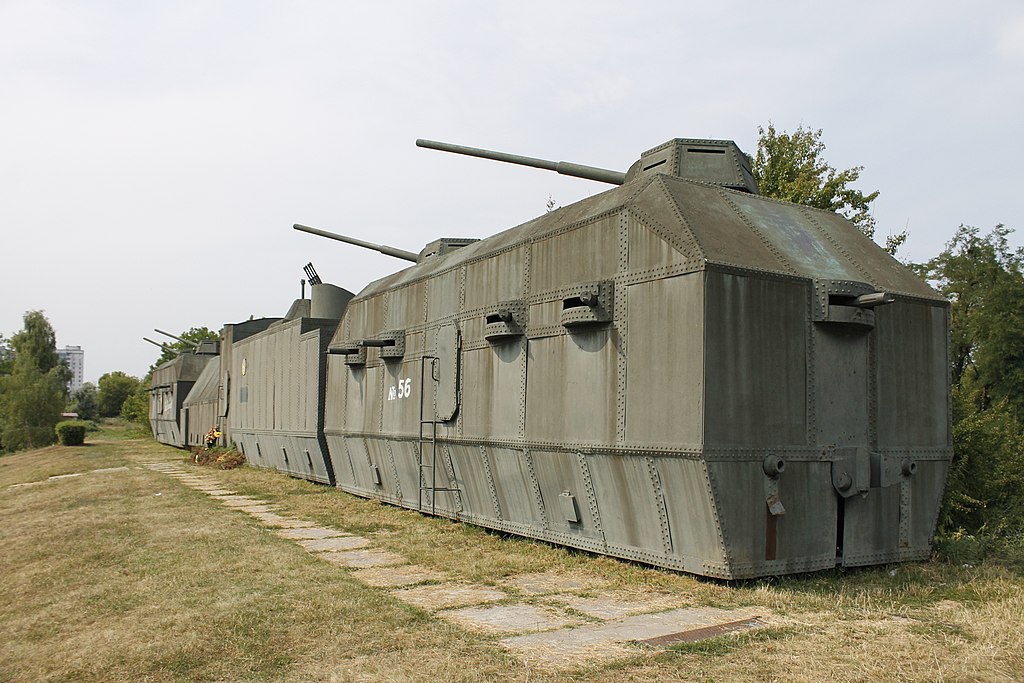
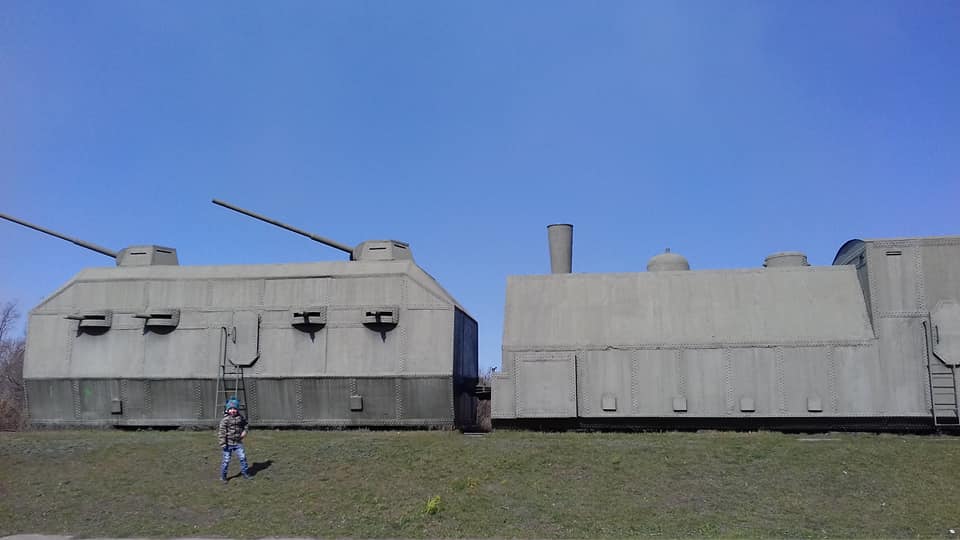
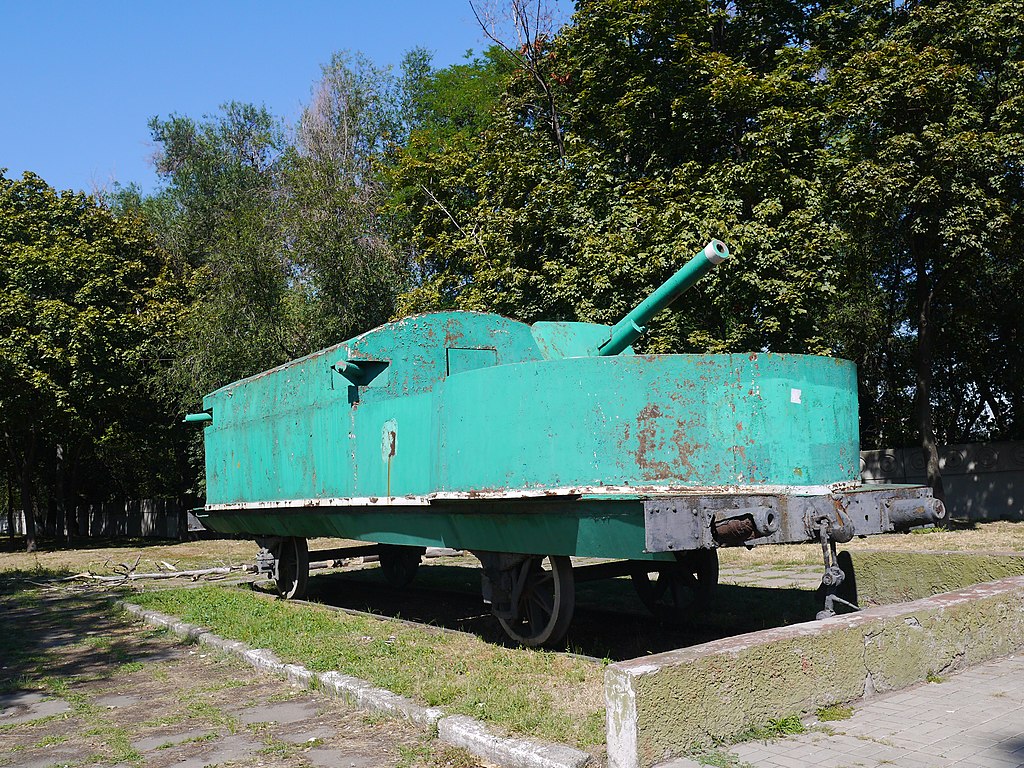
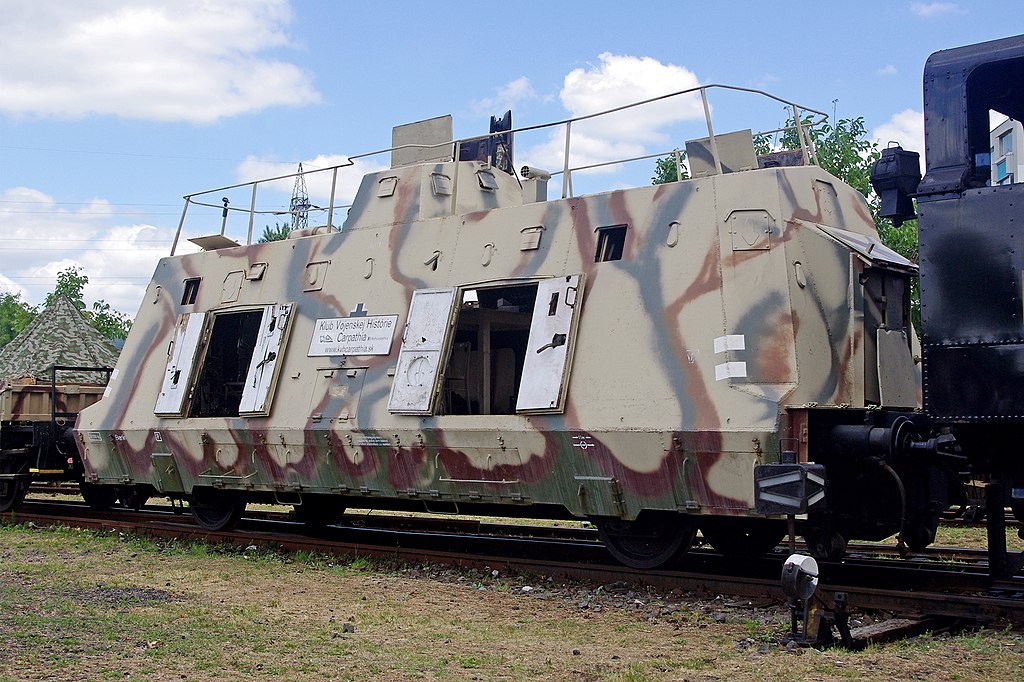
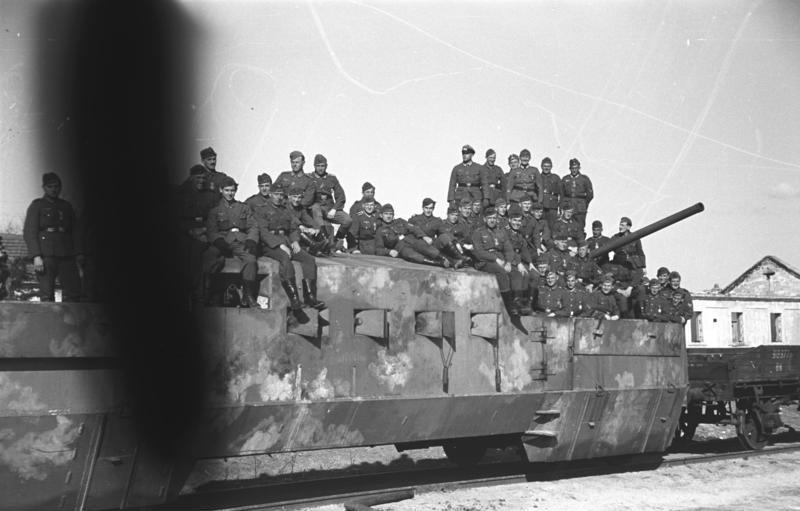
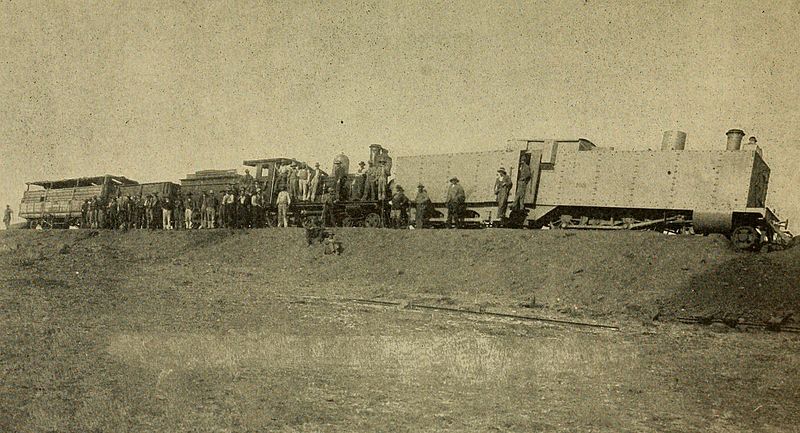
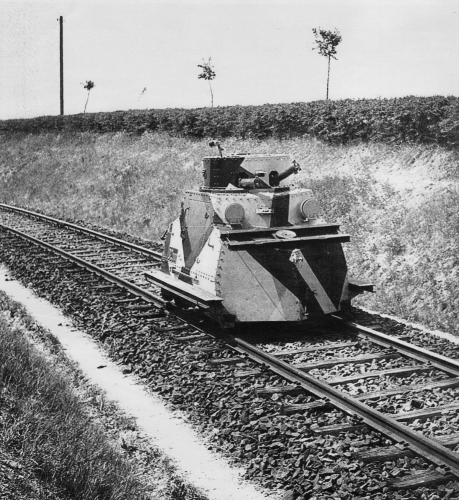
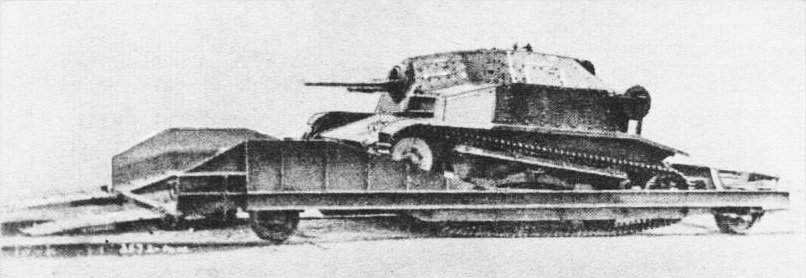
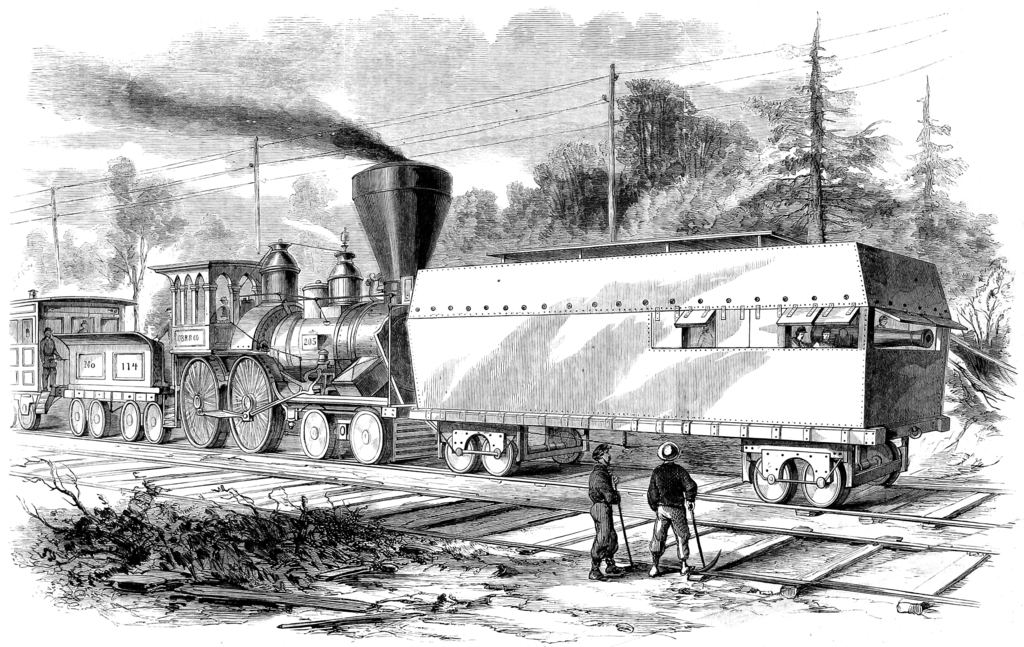

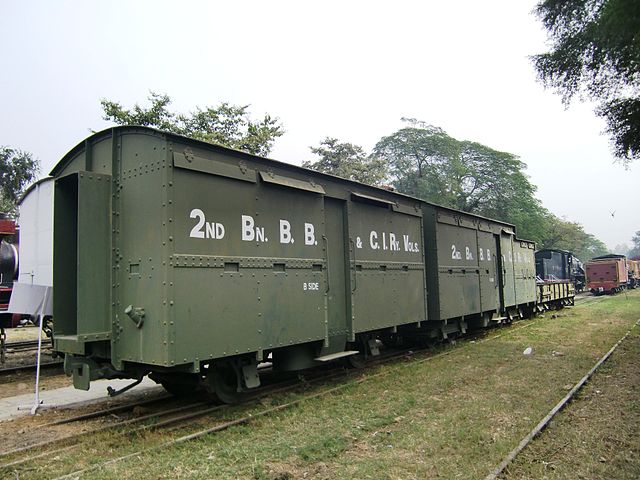
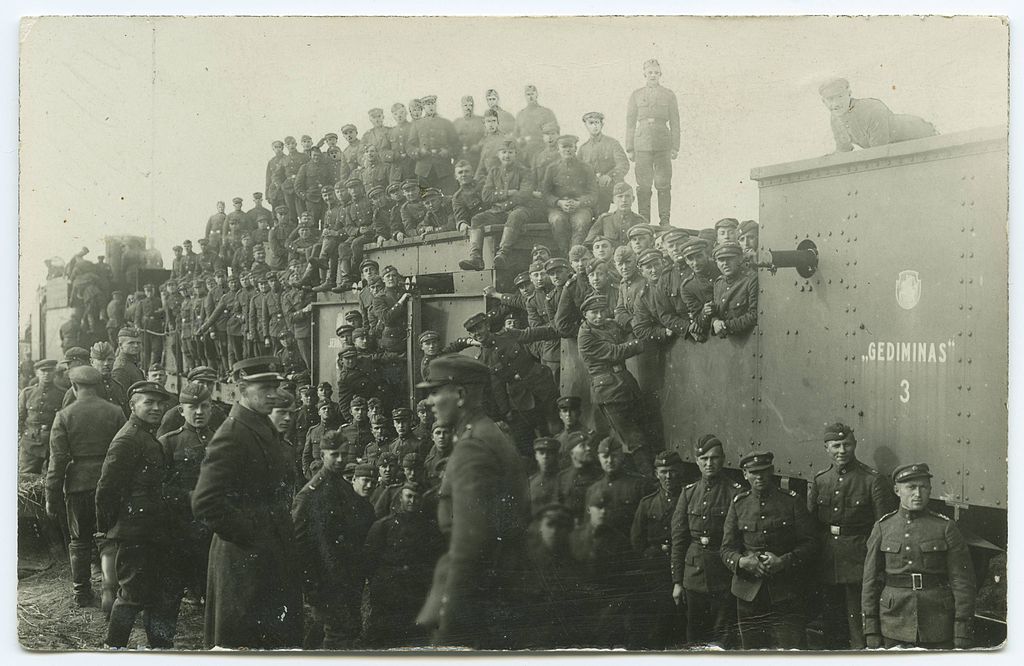
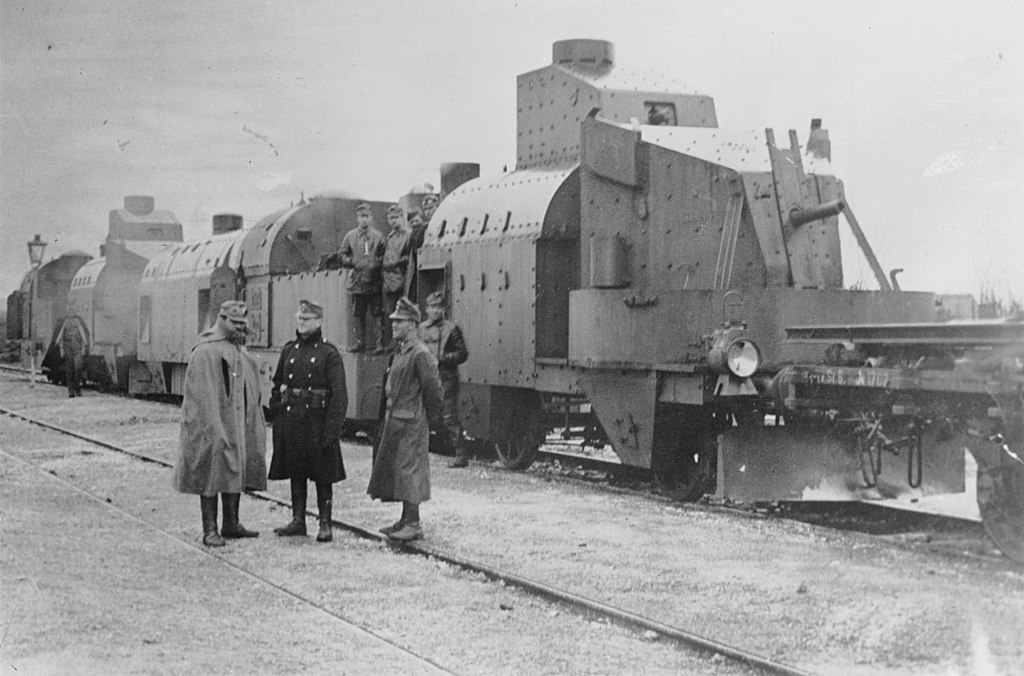
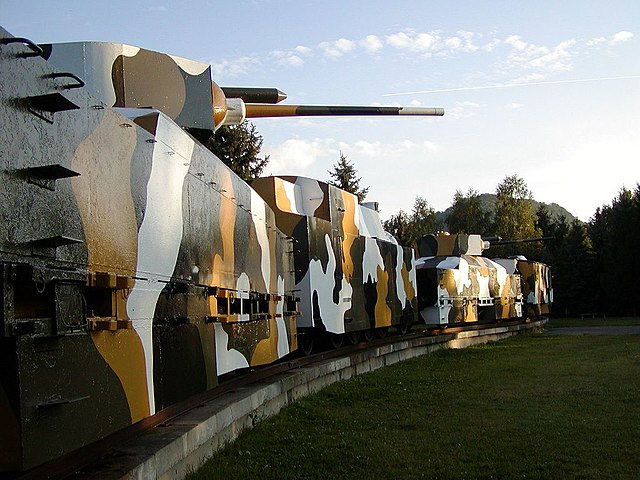
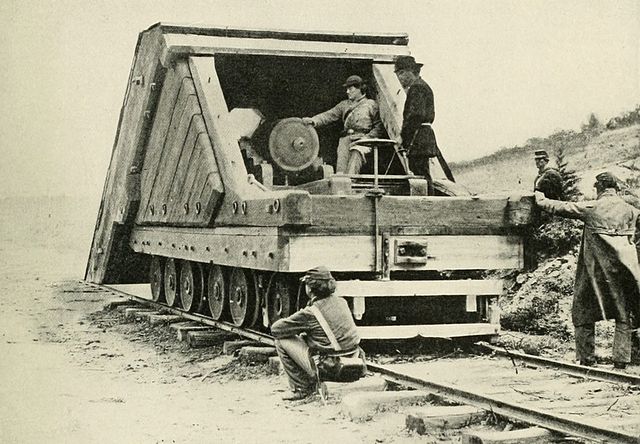

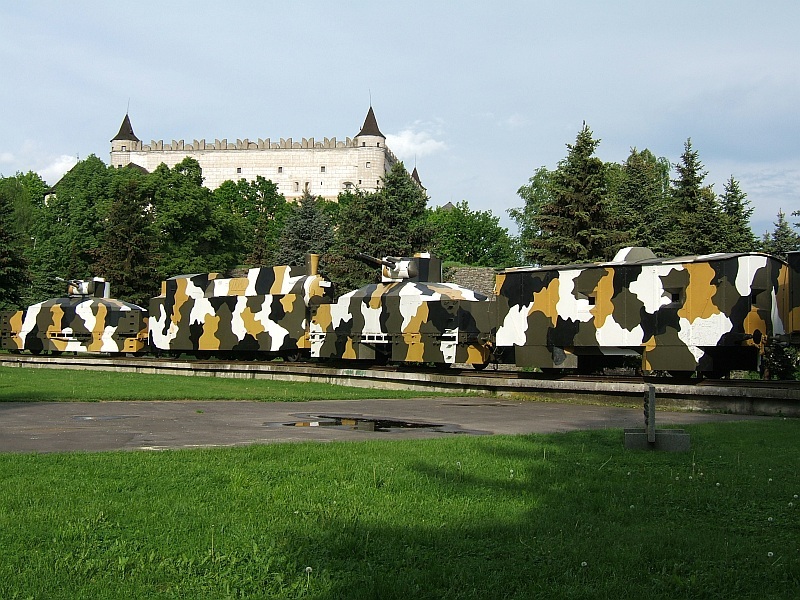
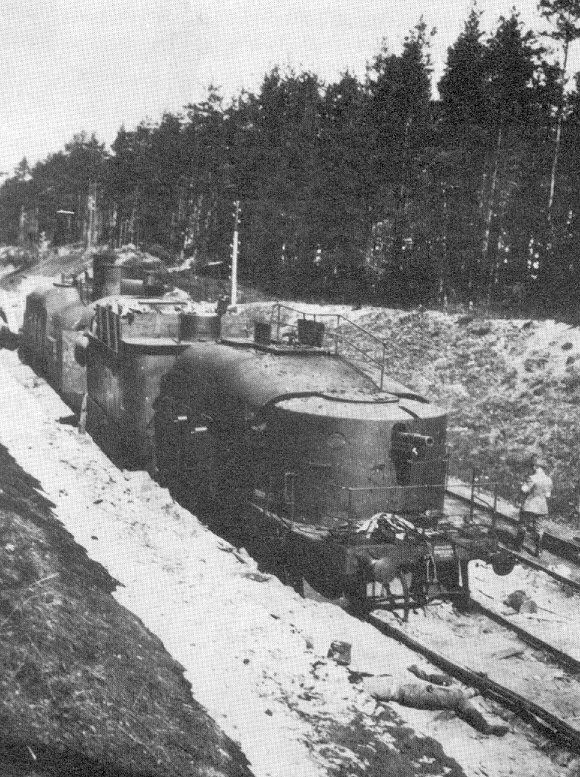

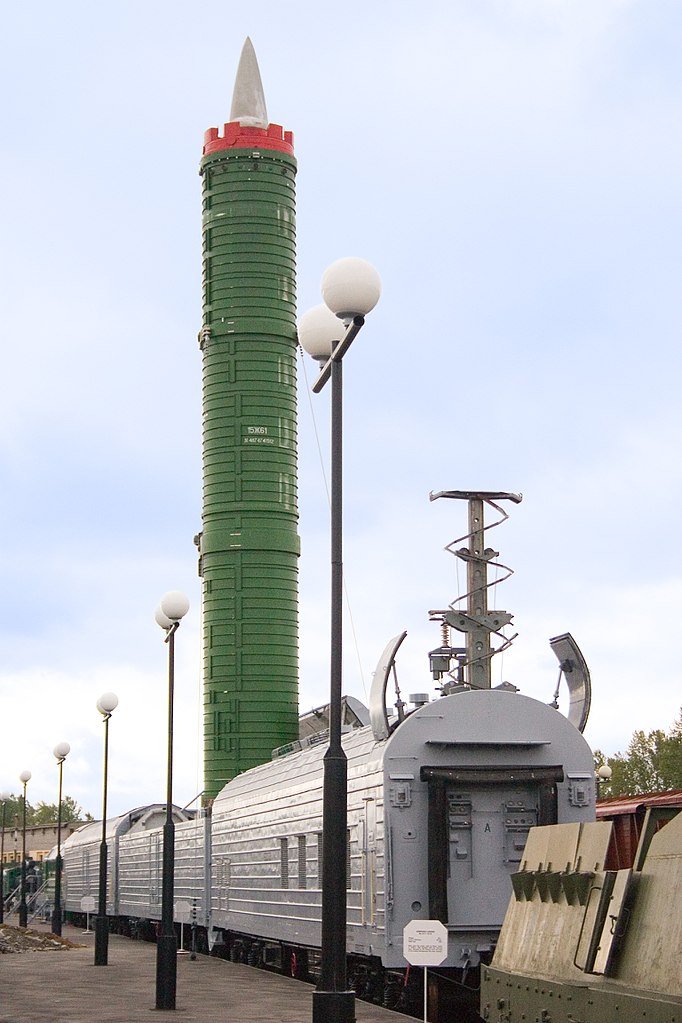

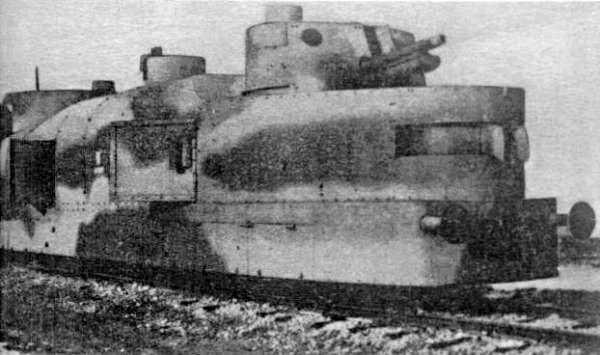
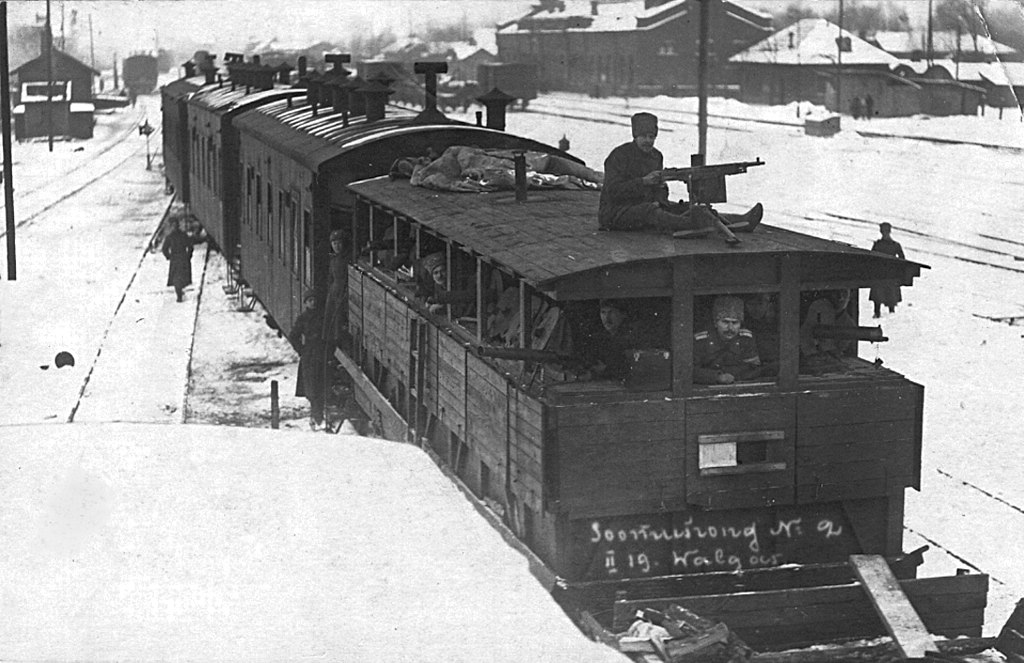
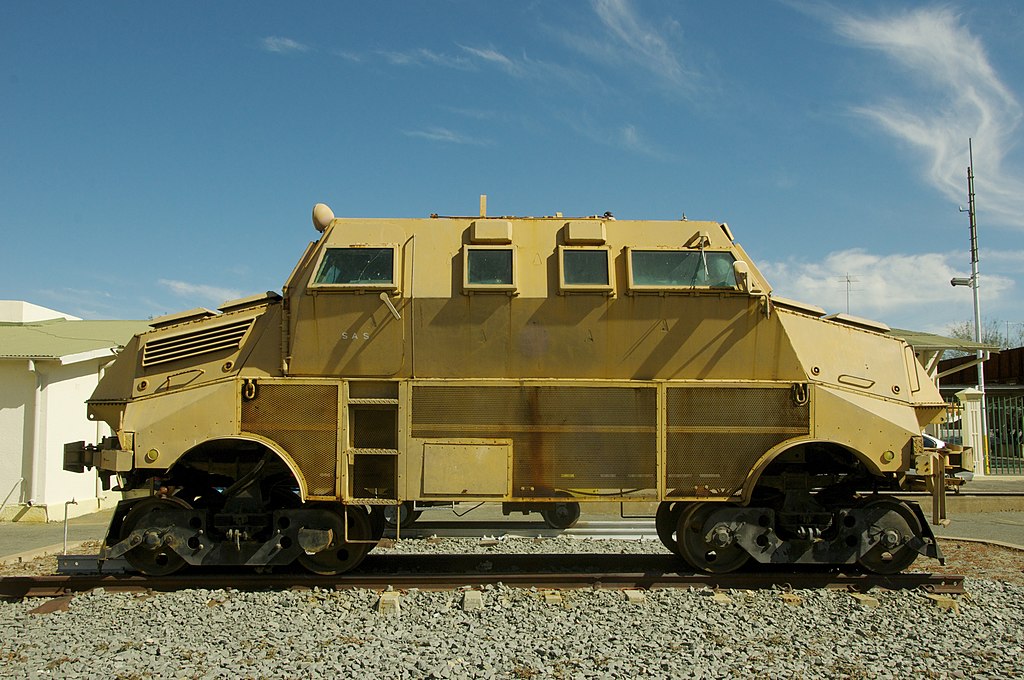
Armored Trains of WW2

A German BP42 armoured train in the Balkans, 1943.
Armored trains were used extensively during World War II by various countries, including Germany, the Soviet Union, Poland, and Romania. These trains were essentially locomotives that had been outfitted with armor plating to protect them from enemy fire, and they were used to transport troops, weapons, and supplies across the front lines.
The Germans used armored trains extensively on the Eastern Front, where they were used to support infantry units and to transport supplies and equipment. One of the most famous German armored trains was the BP 42, which was heavily armed with machine guns, artillery pieces, and anti-aircraft guns. The train was also equipped with searchlights, flamethrowers, and smoke generators, making it a formidable weapon on the battlefield. The Soviet Union also used armored trains extensively during the war. The most famous of these trains was the "Red Arrow," which was used to transport troops and supplies to the front lines. The train was heavily armed with machine guns, anti-aircraft guns, and artillery, and it was protected by thick armor plating.
The Polish Army also had several armored trains, but they were not as heavily armed or armored as those used by the Germans or Soviets. The trains were primarily used to transport troops and supplies, and they were equipped with light machine guns and anti-aircraft guns. In addition to their military uses, armored trains were also used to transport prisoners and concentration camp inmates during the war. The Germans used several armored trains to transport prisoners to concentration camps, including the infamous "Holocaust trains" that transported Jews and other prisoners to their deaths. Overall, armored trains played an important role in the military operations of several countries during World War II, and their use helped to shape the course of the war.
Cold war Armored Trains

A RT-23 Molodets in the Saint Petersburg railway museum
During the Cold War, armored trains continued to be used as a means of transporting troops and equipment across the front lines. However, they were not used as extensively as they were during World War II, as advances in technology had made other means of transportation more effective. The Soviet Union continued to use armored trains during the Cold War, primarily to transport troops and supplies to its western border. These trains were heavily armed and armored, and they were designed to withstand a nuclear attack. The Soviet Union also used armored trains to transport nuclear weapons, as they were considered to be more secure than other means of transportation.
The United States also had armored trains during the Cold War, but they were not as heavily armed or armored as those used by the Soviet Union. The trains were primarily used to transport troops and supplies to military bases, and they were equipped with light machine guns and anti-aircraft guns. Other countries, such as China and North Korea, also had armored trains during the Cold War. These trains were primarily used to transport troops and supplies, and they were equipped with light machine guns and anti-aircraft guns.
Overall, the use of armored trains during the Cold War was limited, as other means of transportation, such as airplanes and helicopters, had become more effective. However, these trains remained an important part of military strategy, and they were used in a number of conflicts during the Cold War, including the Korean War and the Vietnam War.
Src
Books
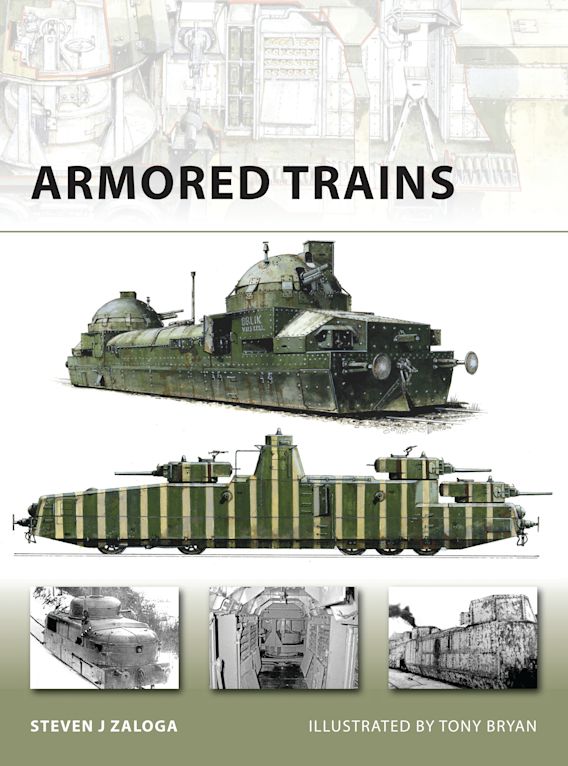
Armored trains by Steve Zaloga, illustrated by Tony Bryan. Summary:First seen during the American Civil War and later appearing in the Franco-Prussian War and the Anglo-Boer Wars, the armored train came to prominence on the Eastern Front during World War I. It was also deployed during the Russian Civil War and the technology traveled east into the Chinese Civil War, and the subsequent war with Japan. It saw service on the Russian Front in World War II, but was increasingly sidelined by its vulnerability to air attack. Steven J Zaloga examines the origins and development of the armored train focusing equally on the technical detail and on the fascinating story of how armored trains were actually used in combat. This title will appeal to armor, military history and railroad enthusiasts alike. From the Trade Paperback edition. preview
Simpson, James (17 July 2015). "A Remarkable Armored Train Fought Its Way Across Eurasia". Medium.
Zaloga, Steve (2011). Armored Trains. Oxford, UK: Bloomsbury Publishing.
Sasaki, Tōichi (1963). Aru gunjin no jiden (in Japanese). Futsūsha. p. 54
Links
WW2 German Armoured Trains on feldgrau.comwinterwar.com/ on Finnish armored Trains
wio.ru/ Nomenclature of Soviet Trains in WW2
www.tankmuseum.ru
rbth.com/
wiki
LA EVOLUCIÓN DE LOS TRENES BLINDADOS
a-remarkable-armored-train-fought-its-way-across-eurasia
download.e-bookshelf.de: Osprey armoured train
Videos
- Baldwin Railroad battery 1861
- No 6 Garrison Arm. Train 1894
- Ladysmith Train 1899
- Crewe Works 1915 coastal train
- French mobile artillery battery (1914)
- Royal Navy armoured Train 1914
- Regia Marina Arm. Trains 1915-18
- Ajmer arm. trains 1916
- Hungarian MAVAG train
- German Panzerzug Ost (1916)
- Bolshevik Armored Tram 1917
- Finnish Arm. Train (1918)
- Zaamurets (Orlík, BP-4, Lenin)
- Khunkhuz
- General Annenkov
- Yenisei
- Amur
- Terek
- Don
- Dywizja Syberyjska trains 1918
- Kozak
- Piłsudczyk
- PP3
- Gromobój
- Pionier
- Śmiały
- Lis-Kula
- Hallerczyk
- Stefan Batory
- Generał Iwaszkiewicz
- Chrobry
- Wilk
- Danuta
- Poznańczyk
- Kaniów
- Zawisza Czarny
- Zagończyk
- Paderewski
- Mściciel
- Reduta Ordona
- Huragan
- Podhalanin
- Bartosz Głowacki
- Pierwszy Marszałek
- Groźny
- Śmierć
- Śmigły
- Stefan Czarniecki
- Generał Sosnkowski
- Putilov armoured trains
- Izhorskiy Armored Train
- Czechoslovak Legion Trains
- Estonian Trains
- Lithuanian Trains
- Zhang Zongchang Train
- Danuta
- Poznańczyk
- Generał Sosnkowski
- Paderewski
- Śmierć
- Pierwszy Marszałek
- Piłsudczyk
- Śmiały
- Groźny
- Bartosz Głowacki
- Smok Kaszubski
- Drezyna R
- Drezyna TK/TKS
- UK dywizjon Trains
- SOK Draisines 1945
- Arm. draisine Crochat
- Austro-Daimler Draisine
- Armoured draisine Tatra T18
- MBV-2 Rail cruiser
- D-2 Draisine (MBV-31)
- D-37 Draisines
- Krasnaja Zvezda (KZ-1)
- D-3 Draisines
- BTD heavy Draisines (5)
- CB-1 Draisines
- DT-45 Draisines
- BD-41 Draisines (12)
- BA-I-Zhd Railcar
- BA-6ZhD Railcar
- BA-20ZhD Railcar
- BA-10Zhd Railcar
- VS-60 Train/Wagon
- BP-35L/H Train
- NKPS-42/Wagon Train (40)
- PL-35 Arty Wagon
- PL-37 Arty Wagon
- PT-35 Arty Wagon
- KV-1 Arty Wagon
- Crimean 76mm univ. Wagon
- "Tank" Wagon
- BP-42 Train/PL-42 Wagon (10)
- BP-43 Train/Wagon (54)
- 7.62mm Maxim SPU-BP Flak wagon (28)
- 37mm PVO-4 FLAK Wagon (120)
- OB-3 Light Wagon
- 27th Div armoured Trains
- 29th Div armoured Trains
- 48th Arm. Div armoured Trains
- "Stalinets" armoured Train
- "Mir Jafar Bagirov" armoured Train
- "Kozma Minin" armoured Train
- "Dzerzhinets" armoured Train
- "Za Rodinu!" armoured Train
- "Kolomensky Rabochy" armoured Train
- Zenitnyy (AA) armoured Trains
- Goering's Asien
- BP42 armoured train (full)
- BP44 armoured train (full)
- Panzerjägerwagen BP44
- BR 52, Steyr Schwerer Schienen Panzer
- Schwerer gustav Train
- P204(f) rail tank
- Schienenkampfwagen SK 1
- Schwerer Spähzug (s.Sp.) Artilleriewagen
- LeichteSchienenkampfwagen 43
- Zeppelin Panzer Draisine
- Panzertriebwagen N17
- Panzertriebwagen N16
- Panzer Draisine Funkwagen
- Panzerdraisine/Pz.III turm
- Panzerdraisine/Pz.IV turm
- Panzer Draisine Le.Sp.
- Panzer Draisine Flakvierling
- S.Panzer Draisine Kugelblitz
- L2670 leichtes panzertriebwagen
- AB Ferroviana
- Littorina OM 36
- LiBli 42
- Type K2 Steam Locomotive No.134
- Type C56 Steam Locomotive No.31
- Type 90 240 mm Railway Cannon (Futtsu Cannon)
- Type 91 Broad-gauge Railroad Tractor (So-Mo)
- Type 94 Armoured Train
- Type 95 Armoured Railroad Car (So-Ki)
- Type 98 Railroad Tractor
- Type 100 Railroad Tractor
- Type 2598 Railroad Car
- Rinji Soko Ressha 1933
- 1940 coastal defence Trains
- Royal Armoured Corps Trains
- Romney, Hythe and Dymchurch Train
- Malaya Arm. train 1942
- 101-104. sz. páncélvonat
- Finnish Winter War Train
- Croatian Armored Train
- Can. Aleutian No.1 Armoured Train
- Slovak resistance armoured train
- Iraqi armoured train (1941)
- Polish 1945-55 trains
- Arm. train La Rafale 1948
- Tren Blindado 1958
- Panser Rel V16 (1955)
- White Train 1957-87
- RT-23 Molodets ballistic wagon
- Trans-Siberian Arm. Train 1970
- North Korean Arm. Train
- Krajina express 1990
- Volga (2022)
- Baikal (2022)
19th Cent. Trains
WW1 Armored Trains
 Poland
Poland
Interwar Armored Trains
WW2 Armored Trains
 France
France
 Austria
Austria
 Czechoslovakia
Czechoslovakia
 USSR
USSR
 Nazi Germany
Nazi Germany
 Italy
Italy
 IJA
IJA
 UK
UK
 Others
Others
☢ Cold war Armored Trains
References
blog.railwaymuseum.org.ukarmedconflicts.com Russian Trains
warhistoryonline.com
feldgrau.com ww2 german trains
cuttersguide.com
wikipedia.org/wiki/Armoured_trains_of_Poland
derela.pl/drais
derela.pl/tatra.htm










